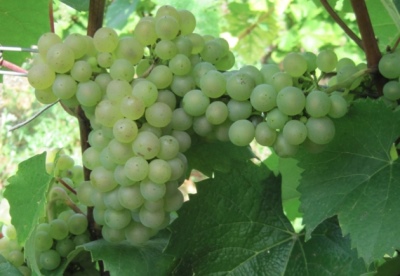
- Appointment: technical
- Berry color: yellow-greenish with dark brown dots
- Taste: ordinary
- With bones: Yes
- Ripening period: early middle
- Ripening period, days: 145
- Frost resistance, ° C: -20
- Name synonyms: Bonois, Vert Blanc, Giboudot Blanc, Griset Blanc, Carcarone, Melon De Jura, Mukhranuli, Pistone, Plant Gris, Troyen Blanc
- Bunch weight, g: 103
- Yield: 4-6 kg per bush, 90-140 kg / ha
Aligote refers to white wine varieties with a long history - it is at least 300 years old. It is appreciated in wineries for its unpretentious cultivation. Resistance to diseases is low - 4 points, as well as to damage by pests.
Breeding history
The variety was bred in France more than three centuries ago. DNA scientific research has recognized Pinot Cepage (now extinct) and Gue Blanc as parent varieties. Aligote is rich in aromatic, flavoring notes in young wines, for which it, in fact, is intended, but also in synonymous names:
Bonois, Vert Blanc;
Giboudot Blanc, Griset Blanc, Carcarone;
Melon De Jura, Mukhranuli, Pistone, Plant Gris, Troyen Blanc.
Grapes have a purely special purpose - as a material for young table wines, dry mono-wine wines, as well as for blending with other varieties, such as Riesling.
Geography of distribution
Aligote occupies large areas in the USA, Australia, Europe - Burgundy, Chardonnay, Switzerland, Bulgaria, Romania, Ukraine, Georgia, in Russia - Crimea, Krasnodar Territory, Rostov Region. But these are not all regions where white grapes grow. He is well known to gardeners of the Urals and South-West Siberia.
Description
Medium-sized strong bushes give vines with good maturation and 80% growth. Reddish-brown annual shoots are covered with slightly dissected five-lobed bright green foliage with a jagged border. By autumn, the leaves change color to lemon yellow. The berry is rich in various vitamins, amino acids, and is also an excellent antioxidant. In addition to winemaking, Aligote is good at canning: juices, compotes, preserves, jams.
Ripening period
The plant in terms of ripening refers to the mid-early, since the CAT required for it is 2766, the approximate time is 145 days.
Bunches
Dense cylindro-conical clusters of small size have an average weight of 103 grams.
Berries
Medium-sized rounded or round berries are colored yellow-green with dark brown blotches. Juicy tender pulp with 1-2 small bones surrounded by a thin skin. Weight 1.8 grams, diameter 12-15 mm. Sugar content 143-231 g / dm³, acidity 7.5-10.4 g / dm³.
Taste
The variety has the usual taste for white wine grapes - sweet-tart with herbaceous and fruity nuances.
Yield
Aligote is renowned for its consistent crop yield with proper farming practices. From a bush get from 4 to 6 kg, sometimes up to 10 kg of berries.


Growing features
Aligote is characterized by unpretentiousness, high marketable and organoleptic qualities, but for its stable fruiting, it is necessary to follow traditional measures for cultivation and care.
Landing
In the southern regions, seedlings are planted in spring and autumn, in regions with a temperate climate - in spring, as the soil warms up to +14.15 degrees. The variety prefers clean, light, neutral-acid chestnut or clay-lime soil, sunny areas protected from cold winds and drafts.
The pits are standard: 80x80x80 cm with a drainage layer of 10-15 cm at the bottom. 30-40 cm of soil enriched with organic and mineral fertilizers (mullein, superphosphate, wood ash) are poured onto the drainage, after which a seedling is planted. The roots are dipped in a mash made of mullein and clay, gently spread over the surface, sprinkled with earth, leaving the root collar open. The trunk circle is spilled with two buckets of warm water, after a couple of days the earth is loosened and covered with a layer of mulch.

Pollination
Bisexual flowering saves gardeners from additional pollination measures. The plant is perfectly self-pollinated.
Pruning
The bush needs normalization - no more than 50 eyes, and pruning - 10 buds.

Watering
Aligote needs moderate watering with warm water in the evening no more than 2-3 times per season (during flowering, berry ripening, after harvesting) under favorable weather conditions. During the dry period, the vine is watered when the foliage begins to brighten, the leaf becomes thinner, drooping. Moisture consumption 50 liters per square meter or one bush.


Top dressing
In the spring, nitrogen-phosphorus fertilizers are applied, stimulating the growth of green mass, flowering and fruiting. In addition, during the growing season, the bushes require potash fertilizing, as well as copper, iron, ammonium nitrate, and wood ash.
Frost resistance and the need for shelter
Aligote has good frost resistance, down to -20ºC, but it can winter without shelter only in a southern climate. In cold areas, the vine is removed from the support, bent to the ground, covered with spruce branches, reeds, straw, and agrotextile on top. Where winters are especially frosty, snow is raked from above.

Diseases and pests
The variety can be affected by oidium, mildew, anthracnose, gray mold, resistance 4 points (susceptibility) - a strong tumor reaction. Of the pests, spider mites, aphids, thrips, and worms are especially dangerous for him. As a preventive measure, spraying with fungicides, copper sulfate, insecticides is carried out.

If the grapes are exposed to any disease or insect, this is always reflected in its appearance.
Storage
The harvested crop is stored in cool rooms with ventilation and moderate humidity.











































































